- Home
- Register Here
- Products
- Download Center
- Collaborative Learning
- Biology Activities
- Music Activities
- Chemistry Activities
- Geography Activities
- History Activities
- Ancient & Modern Olympics
- Ancient Greek and Modern Education
- Antisemitism and Anne Frank
- Arachne
- Aztec Tributes Game
- Catch the Plague
- Egypt Quiz
- Greek Farming
- Greek Gods Identity Parade
- Henry VIII's Six Wives
- Medieval Snakes and Ladders
- Perseus and the Gorgon
- Slave Rebellions
- Technology and the Wilsons
- Tudor Entertainments
- Underlying Causes of First World War
- Victorian Working Life
- WW2 Air Raids
- Literacy Activities
- Buri and the Marrow
- Classic Tales
- Collection
- Complex Sentences
- Compound Nouns
- Consonant Clusters
- Don’t Cry Sly Fox
- Double or Single Consonants
- Feelings Synonyms
- Frequent Words
- Giant Turnip Rhyming Words
- Greek Word Detective
- Haiku
- Holes - Louis Sachar
- Improving Adjectives
- It could have happened, but in fact it didn't
- Macbeth - Close Look at Act One
- Macbeth - Macbeth's Feelings
- Macbeth - Two Minute Autobiography
- Macbeth Connect Four
- Not Again Red Riding Hood (Lotto Game)
- Not Again Red Riding Hood (Track Game)
- Oliver Twist
- Plural Monsters Machine and "One or More than One" Spelling Game
- Prefix Connect Four
- Prefix Pairs
- Punctuation Game
- Silent Letters
- Simile Bingo
- Sufficient Suffixes
- Suffix Trees
- The Elves and the Shoemaker
- The Giant Turnip (Bingo Game)
- Too Many Apostrophes
- Vowels (Connect Four)
- Maths Activities
- 12 and 24 Hour Clock
- Adding Two Digit Numbers
- Battle for Angle Forest
- Bigger or Smaller than Half
- Book Mystery
- Buy a Bear
- Change
- Decimal Street
- Doubling Cards
- Football Scores
- Four In a Row
- Fraction Frolics
- How Much How Many
- Maths Vocabulary
- Measuring
- More or Less (10-100)
- More than, Less than
- Number Balance
- Number Bonds
- Perfect Paint Palette
- Probability
- Regular Polygons
- Shape Monsters
- Transformations
- PSHE Activites
- Physics Activities
- Download Activities
- Interactive Demo
- Videos & Instructions
Collaborative Learning : Chemistry Activities
| Title | Image |
|---|---|
Decay
Learning Outcomes: Pupils will be able to describe rates of decay in detail, research and narrate their findings. |
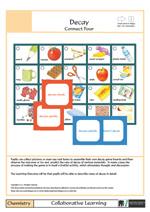 |
QualitiesDescription: Sorting and classifying are important parts of science and in this activity we have concentrated on the different physical qualities of everyday objects. If you add different sets of object pictures or translate the game into different languages please send them to the address below for expanding our library. Learning Outcomes: Pupils will be able to define and describe the different qualities objects have. |
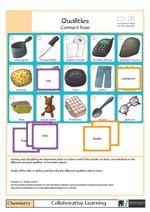 |
ElementsDescription: We are always trying to think of activities to make revision fun and this is essentially such an activity turned into an interactive game. For students to further test their knowledge we have also included an Elements Quiz. Learning Outcomes: Students will have increased their knowledge of the twelve elements featured in this activity. |
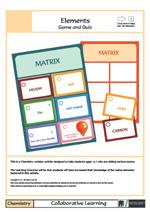 |
Burning DominoesDescription: This dominoes activity is designed to consolidate the spelling and meanings of scientific vocabulary. Learning Outcomes: Students will be able to identify the different types of chemical reactions and their meanings. |
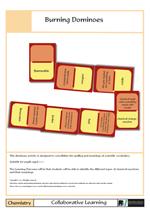 |
Acid and AlkalisDescription: This matching activity is designed to enable students to understand the nature of the continuum from strong acid through neutral substance to strong alkali and it encourages pupils to work collaboratively to complete their task. Learning Outcomes: Students will have reinforced their knowledge of the relationship between substance description, pH number and universal indicator colour. |
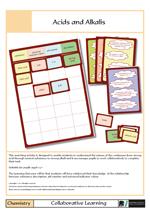 |

